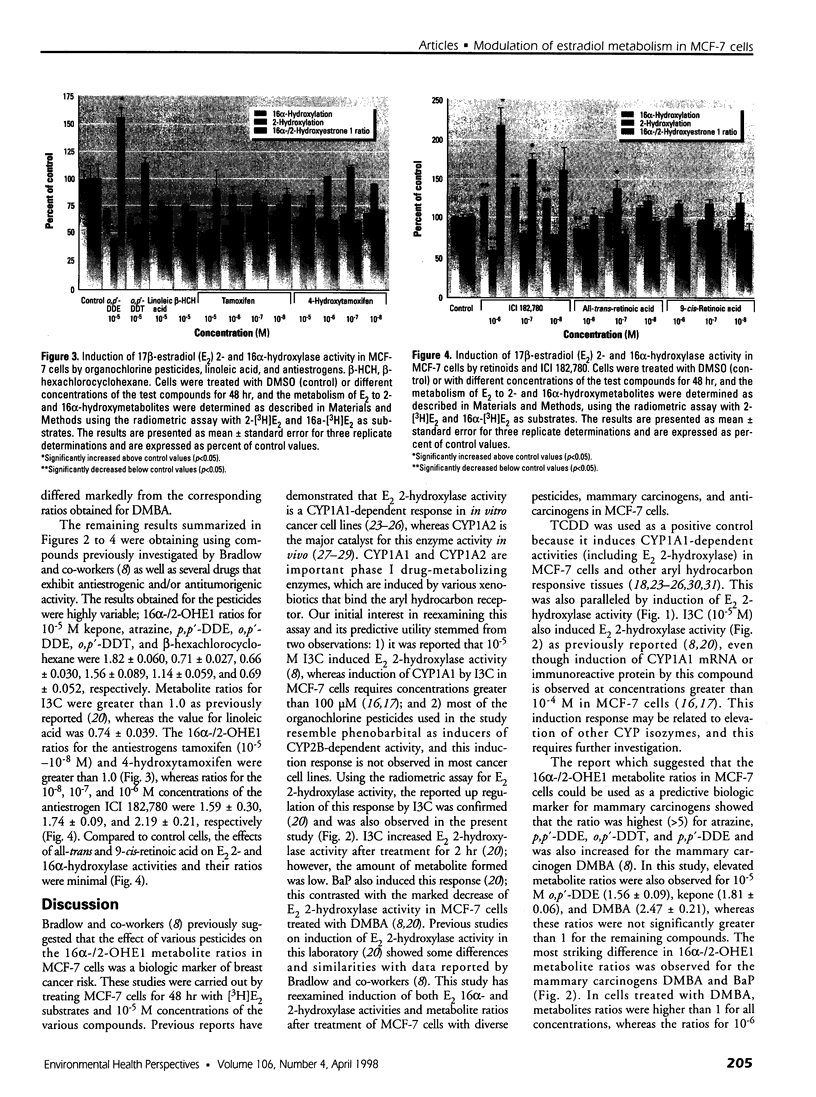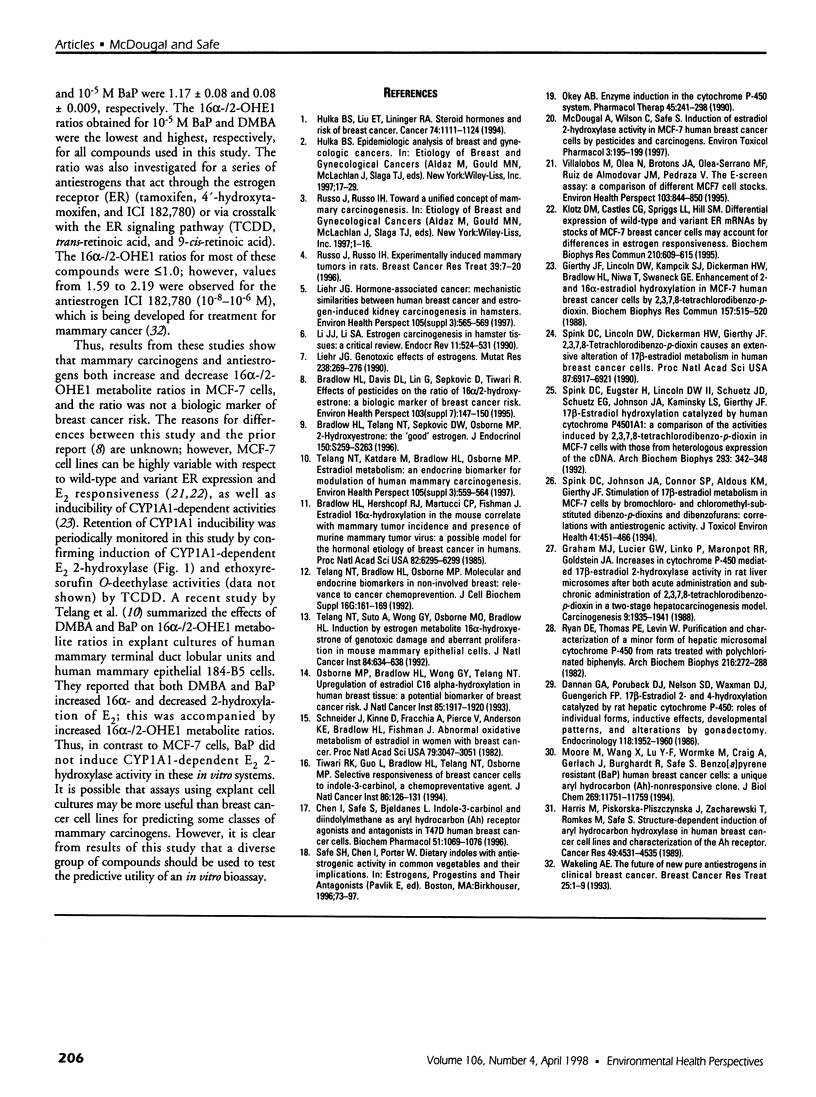Abstract
The effects of several pesticides, mammary carcinogens, and antiestrogens on 17beta-estradiol (E2), 16alpha- and 2-hydroxylase activities, and 16alpha-/2-hydroxyestrone (OHE1) ratios were investigated in MCF-7 cells using a radiometric assay. The mammary carcinogens 7,12-dimethylbenz[a]anthracene (DMBA) and benzo[a]pyrene (BaP), respectively, increased and decreased 16alpha-/2-OHE1 ratios at some concentrations. The 16alpha-/2-OHE1 metabolite ratios for 10(-5) M kepone, atrazine, p,p'-DDE, o,p'-DDE, o,p'-DDT, and beta-hexachlorocyclohexane were 1.82 +/- 0.060, 0.71 +/- 0.027, 0.66 +/- 0.030, 1.56 +/- 0.089, 1.14 +/- 0.059, and 0.69 +/- 0.052 (mean +/- standard error), respectively, and did not show any specific trend. The effects of a series of direct and indirect acting antiestrogens on 16alpha-/2-OHE1 metabolite ratios were also investigated, and the results were compound specific. Indole-3-carbinol, tamoxifen, 4'-hydroxytamoxifen, and 9-cis,retinoic acid decreased the ratio; the effects of all trans-retinoic acid and 2,3,7,8-tetrachlorodibenzo-p-dioxin were concentration dependent; the antiestrogen ICI 182,780 increased the 16alpha-/2-OHE1 metabolite ratio. The results indicate that in MCF-7 cells treated with pesticides, mammary carcinogens, and antiestrogens, there were both increased and decreased 16alpha-/2-OHE1 metabolite ratios for each class of chemicals and the assay did not predict mammary carcinogens.
Full text
PDF



Images in this article
Selected References
These references are in PubMed. This may not be the complete list of references from this article.
- Bradlow H. L., Davis D. L., Lin G., Sepkovic D., Tiwari R. Effects of pesticides on the ratio of 16 alpha/2-hydroxyestrone: a biologic marker of breast cancer risk. Environ Health Perspect. 1995 Oct;103 (Suppl 7):147–150. doi: 10.1289/ehp.95103s7147. [DOI] [PMC free article] [PubMed] [Google Scholar]
- Bradlow H. L., Hershcopf R. J., Martucci C. P., Fishman J. Estradiol 16 alpha-hydroxylation in the mouse correlates with mammary tumor incidence and presence of murine mammary tumor virus: a possible model for the hormonal etiology of breast cancer in humans. Proc Natl Acad Sci U S A. 1985 Sep;82(18):6295–6299. doi: 10.1073/pnas.82.18.6295. [DOI] [PMC free article] [PubMed] [Google Scholar]
- Bradlow H. L., Telang N. T., Sepkovic D. W., Osborne M. P. 2-hydroxyestrone: the 'good' estrogen. J Endocrinol. 1996 Sep;150 (Suppl):S259–S265. [PubMed] [Google Scholar]
- Chen I., Safe S., Bjeldanes L. Indole-3-carbinol and diindolylmethane as aryl hydrocarbon (Ah) receptor agonists and antagonists in T47D human breast cancer cells. Biochem Pharmacol. 1996 Apr 26;51(8):1069–1076. doi: 10.1016/0006-2952(96)00060-3. [DOI] [PubMed] [Google Scholar]
- Dannan G. A., Porubek D. J., Nelson S. D., Waxman D. J., Guengerich F. P. 17 beta-estradiol 2- and 4-hydroxylation catalyzed by rat hepatic cytochrome P-450: roles of individual forms, inductive effects, developmental patterns, and alterations by gonadectomy and hormone replacement. Endocrinology. 1986 May;118(5):1952–1960. doi: 10.1210/endo-118-5-1952. [DOI] [PubMed] [Google Scholar]
- Gierthy J. F., Lincoln D. W., 2nd, Kampcik S. J., Dickerman H. W., Bradlow H. L., Niwa T., Swaneck G. E. Enhancement of 2- and 16 alpha-estradiol hydroxylation in MCF-7 human breast cancer cells by 2,3,7,8-tetrachlorodibenzo-P-dioxin. Biochem Biophys Res Commun. 1988 Dec 15;157(2):515–520. doi: 10.1016/s0006-291x(88)80279-1. [DOI] [PubMed] [Google Scholar]
- Graham M. J., Lucier G. W., Linko P., Maronpot R. R., Goldstein J. A. Increases in cytochrome P-450 mediated 17 beta-estradiol 2-hydroxylase activity in rat liver microsomes after both acute administration and subchronic administration of 2,3,7,8-tetrachlorodibenzo-p-dioxin in a two-stage hepatocarcinogenesis model. Carcinogenesis. 1988 Nov;9(11):1935–1941. doi: 10.1093/carcin/9.11.1935. [DOI] [PubMed] [Google Scholar]
- Harris M., Piskorska-Pliszczynska J., Zacharewski T., Romkes M., Safe S. Structure-dependent induction of aryl hydrocarbon hydroxylase in human breast cancer cell lines and characterization of the Ah receptor. Cancer Res. 1989 Aug 15;49(16):4531–4535. [PubMed] [Google Scholar]
- Hulka B. S., Liu E. T., Lininger R. A. Steroid hormones and risk of breast cancer. Cancer. 1994 Aug 1;74(3 Suppl):1111–1124. doi: 10.1002/1097-0142(19940801)74:3+<1111::aid-cncr2820741520>3.0.co;2-l. [DOI] [PubMed] [Google Scholar]
- Klotz D. M., Castles C. G., Fuqua S. A., Spriggs L. L., Hill S. M. Differential expression of wild-type and variant ER mRNAs by stocks of MCF-7 breast cancer cells may account for differences in estrogen responsiveness. Biochem Biophys Res Commun. 1995 May 16;210(2):609–615. doi: 10.1006/bbrc.1995.1702. [DOI] [PubMed] [Google Scholar]
- Li J. J., Li S. A. Estrogen carcinogenesis in hamster tissues: a critical review. Endocr Rev. 1990 Nov;11(4):524–531. doi: 10.1210/edrv-11-4-524. [DOI] [PubMed] [Google Scholar]
- Liehr J. G. Genotoxic effects of estrogens. Mutat Res. 1990 May;238(3):269–276. doi: 10.1016/0165-1110(90)90018-7. [DOI] [PubMed] [Google Scholar]
- Liehr J. G. Hormone-associated cancer: mechanistic similarities between human breast cancer and estrogen-induced kidney carcinogenesis in hamsters. Environ Health Perspect. 1997 Apr;105 (Suppl 3):565–569. doi: 10.1289/ehp.97105s3565. [DOI] [PMC free article] [PubMed] [Google Scholar]
- Moore M., Wang X., Lu Y. F., Wormke M., Craig A., Gerlach J. H., Burghardt R., Barhoumi R., Safe S. Benzo[a]pyrene-resistant MCF-7 human breast cancer cells. A unique aryl hydrocarbon-nonresponsive clone. J Biol Chem. 1994 Apr 22;269(16):11751–11759. [PubMed] [Google Scholar]
- Okey A. B. Enzyme induction in the cytochrome P-450 system. Pharmacol Ther. 1990;45(2):241–298. doi: 10.1016/0163-7258(90)90030-6. [DOI] [PubMed] [Google Scholar]
- Osborne M. P., Bradlow H. L., Wong G. Y., Telang N. T. Upregulation of estradiol C16 alpha-hydroxylation in human breast tissue: a potential biomarker of breast cancer risk. J Natl Cancer Inst. 1993 Dec 1;85(23):1917–1920. doi: 10.1093/jnci/85.23.1917. [DOI] [PubMed] [Google Scholar]
- Russo J., Russo I. H. Experimentally induced mammary tumors in rats. Breast Cancer Res Treat. 1996;39(1):7–20. doi: 10.1007/BF01806074. [DOI] [PubMed] [Google Scholar]
- Ryan D. E., Thomas P. E., Levin W. Purification of characterization of a minor form of hepatic microsomal cytochrome P-450 from rats treated with polychlorinated biphenyls. Arch Biochem Biophys. 1982 Jun;216(1):272–288. doi: 10.1016/0003-9861(82)90212-0. [DOI] [PubMed] [Google Scholar]
- Schneider J., Kinne D., Fracchia A., Pierce V., Anderson K. E., Bradlow H. L., Fishman J. Abnormal oxidative metabolism of estradiol in women with breast cancer. Proc Natl Acad Sci U S A. 1982 May;79(9):3047–3051. doi: 10.1073/pnas.79.9.3047. [DOI] [PMC free article] [PubMed] [Google Scholar]
- Spink D. C., Eugster H. P., Lincoln D. W., 2nd, Schuetz J. D., Schuetz E. G., Johnson J. A., Kaminsky L. S., Gierthy J. F. 17 beta-estradiol hydroxylation catalyzed by human cytochrome P450 1A1: a comparison of the activities induced by 2,3,7,8-tetrachlorodibenzo-p-dioxin in MCF-7 cells with those from heterologous expression of the cDNA. Arch Biochem Biophys. 1992 Mar;293(2):342–348. doi: 10.1016/0003-9861(92)90404-k. [DOI] [PubMed] [Google Scholar]
- Spink D. C., Johnson J. A., Connor S. P., Aldous K. M., Gierthy J. F. Stimulation of 17 beta-estradiol metabolism in MCF-7 cells by bromochloro- and chloromethyl-substituted dibenzo-p-dioxins and dibenzofurans: correlations with antiestrogenic activity. J Toxicol Environ Health. 1994 Apr;41(4):451–466. doi: 10.1080/15287399409531856. [DOI] [PubMed] [Google Scholar]
- Spink D. C., Lincoln D. W., 2nd, Dickerman H. W., Gierthy J. F. 2,3,7,8-Tetrachlorodibenzo-p-dioxin causes an extensive alteration of 17 beta-estradiol metabolism in MCF-7 breast tumor cells. Proc Natl Acad Sci U S A. 1990 Sep;87(17):6917–6921. doi: 10.1073/pnas.87.17.6917. [DOI] [PMC free article] [PubMed] [Google Scholar]
- Telang N. T., Bradlow H. L., Osborne M. P. Molecular and endocrine biomarkers in non-involved breast: relevance to cancer chemoprevention. J Cell Biochem Suppl. 1992;16G:161–169. doi: 10.1002/jcb.240501128. [DOI] [PubMed] [Google Scholar]
- Telang N. T., Katdare M., Bradlow H. L., Osborne M. P. Estradiol metabolism: an endocrine biomarker for modulation of human mammary carcinogenesis. Environ Health Perspect. 1997 Apr;105 (Suppl 3):559–564. doi: 10.1289/ehp.97105s3559. [DOI] [PMC free article] [PubMed] [Google Scholar]
- Telang N. T., Suto A., Wong G. Y., Osborne M. P., Bradlow H. L. Induction by estrogen metabolite 16 alpha-hydroxyestrone of genotoxic damage and aberrant proliferation in mouse mammary epithelial cells. J Natl Cancer Inst. 1992 Apr 15;84(8):634–638. doi: 10.1093/jnci/84.8.634. [DOI] [PubMed] [Google Scholar]
- Tiwari R. K., Guo L., Bradlow H. L., Telang N. T., Osborne M. P. Selective responsiveness of human breast cancer cells to indole-3-carbinol, a chemopreventive agent. J Natl Cancer Inst. 1994 Jan 19;86(2):126–131. doi: 10.1093/jnci/86.2.126. [DOI] [PubMed] [Google Scholar]
- Villalobos M., Olea N., Brotons J. A., Olea-Serrano M. F., Ruiz de Almodovar J. M., Pedraza V. The E-screen assay: a comparison of different MCF7 cell stocks. Environ Health Perspect. 1995 Sep;103(9):844–850. doi: 10.1289/ehp.95103844. [DOI] [PMC free article] [PubMed] [Google Scholar]
- Wakeling A. E. The future of new pure antiestrogens in clinical breast cancer. Breast Cancer Res Treat. 1993;25(1):1–9. doi: 10.1007/BF00662395. [DOI] [PubMed] [Google Scholar]






